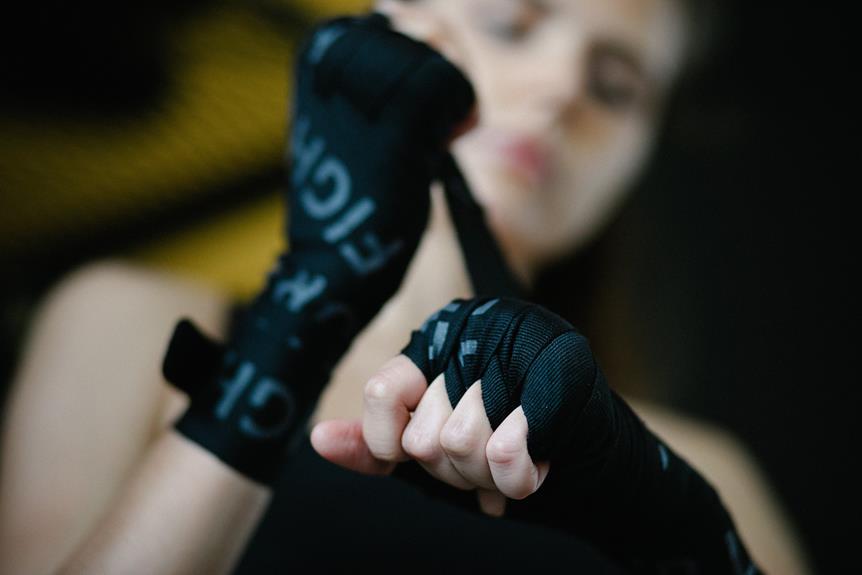If you want to master the art of hand stitching elastic, there are 5 essential techniques to explore.
Each method offers its own unique advantages, ensuring that you have the perfect solution for any project.
From the zigzag stitch for durability to the loop and tack for adjustability, these methods provide the versatility you need for various sewing applications.
Mastering these techniques will elevate your sewing skills, allowing you to confidently work with elastic in any garment or project.
Key Takeaways
- Zigzag Stitch Method is used to secure elastic with back stitches at one end and stitching along the edge of the elastic.
- Casing Method involves creating a casing and using a gathering technique to evenly distribute fabric along the elastic.
- Overlapping Method requires overlapping the elastic ends by about 1 inch and hand stitching them together with strong thread.
- Whipstitch Method involves looping the thread over the edge of the elastic and maintaining even spacing between each stitch to prevent fabric puckering.
Zigzag Stitch Method
You can start the zigzag stitch method by securing the elastic at one end of the fabric with a few back stitches. Set your sewing machine to a zigzag stitch and adjust the thread tension to ensure the stitches are neither too loose nor too tight. A moderate tension usually works well for elastic.
Use a ballpoint or stretch needle in a size appropriate for the weight of your fabric. The needle should penetrate the fabric without causing any runs or snags in the elastic.
Begin stitching along the edge of the elastic, making sure to gently pull and guide the elastic to match the desired length of the fabric. The zigzag stitch allows for flexibility, preventing the stitches from breaking when the fabric stretches.
Once you reach the end, secure the elastic with a few back stitches. Check the overall stretch and adjust the thread tension or stitch length if necessary.
With practice, mastering the zigzag stitch method for attaching elastic becomes second nature.
Casing Method
Using a needle, thread, and your fabric of choice, begin by folding over the edge and stitching a straight line to create a channel for the elastic. The casing method provides a clean and professional finish for your elastic application. Here's how to master this technique:
- Gathering Technique: Before inserting the elastic, use a gathering technique such as basting stitches to evenly distribute the fabric along the length of the elastic. This ensures a smooth and uniform gather.
- Elastic Insertion: After securing one end of the elastic, use a safety pin or elastic guide to thread the elastic through the casing. Be mindful to avoid twisting the elastic during this process for a neat and uniform result.
- Seamless Finishes: Once the elastic is evenly distributed and reaches the other end of the casing, securely stitch the ends of the elastic together and adjust the gathers as needed. Ensure the stitches are robust to withstand the tension of the elastic.
Mastering the casing method will provide you with a seamless finish and secure elastic attachment, ensuring your garments have a professional and polished look.
Overlapping Method
To transition from the casing method to the overlapping method, ensure the gathered fabric is evenly distributed along the elastic for a smooth and uniform finish. Start by overlapping the elastic ends by about 1 inch and pin them in place.
It's crucial to maintain a consistent elastic tension as you hand stitch the overlapped area. Using a needle size appropriate for the fabric and elastic will ensure that the stitches are secure without causing any damage to the elastic.
When hand stitching the overlapped section, make sure to use a strong, matching thread to provide durability. Sew through the overlapped area multiple times in a secure and even manner to prevent the elastic from slipping or bunching up.
Once finished, trim any excess elastic and thread. The overlapping method allows for a seamless and secure finish that evenly distributes the elastic tension, providing a comfortable and professional-looking result.
Whipstitch Method
Transition from the overlapping method to the whipstitch method by securing the gathered fabric evenly along the elastic for a smooth and uniform finish.
When applying elastic using the whipstitch method, keep these key techniques in mind:
- Stitch Placement: Position the elastic and fabric layers together, ensuring they're aligned properly before beginning the whipstitch. This will help maintain a consistent tension and prevent the fabric from puckering.
- Needle Positioning: Insert the needle through the fabric and elastic, then loop the thread over the edge of the elastic to secure it in place. Repeat this process, maintaining even spacing between each stitch for a professional-looking result.
- Tension Control: Maintain a steady tension on the elastic and fabric as you whipstitch, ensuring that the elastic gathers evenly and smoothly along the fabric edge.
Loop and Tack Method
For the loop and tack method of hand stitching elastic, align the elastic and fabric layers to ensure even distribution before beginning the process. This technique is essential for maintaining proper elastic tension and ensuring the durability of the elastic over time. The loop and tack method involves creating small loops with the elastic and tacking them down at intervals to secure them to the fabric. This method provides excellent stitch strength and prevents the elastic from becoming loose or unevenly distributed.
To help you understand the loop and tack method better, here is a table comparing it with other hand stitching techniques:
| Hand Stitching Techniques | Elastic Tension | Stitch Strength | Durability |
|---|---|---|---|
| Loop and Tack Method | Maintained | Excellent | High |
| Whipstitch Method | Variable | Moderate | Moderate |
| Running Stitch Method | Variable | Low | Low |
Frequently Asked Questions
Can I Use a Regular Sewing Machine to Stitch Elastic Onto Fabric?
Yes, you can use a regular sewing machine to stitch elastic onto fabric. Make sure to use a zigzag stitch to accommodate the elastic stretchiness. Adjust the machine's tension and stitch length for best results.
What Type of Thread Should I Use for Hand Stitching Elastic?
When hand stitching elastic, ensure you use a thread that's compatible with stretch fabrics. Opt for a polyester or nylon thread, as they offer good elasticity and durability. Use a stretch stitch or zigzag technique for best results.
How Do I Determine the Length of Elastic Needed for My Project?
To determine the length of elastic needed for your project, measure the area where the elastic will be applied and add a small amount for overlap. Consider the stretch factor and sewing techniques for a precise fit.
Can I Use Different Types of Elastic for Different Projects?
Yes, you can use different types of elastic for various projects. Consider the project's requirements, such as fabric compatibility and the level of stretch needed. Different elastic types suit different projects, so choose the right one accordingly.
Can I Hand Stitch Elastic Onto Stretchy or Slippery Fabrics?
Yes, you can hand stitch elastic onto stretchy or slippery fabrics. When stitching elastic onto slippery fabric, use a zigzag stitch to prevent slipping. Ensure the elastic is compatible with the fabric for optimal results.
- The Use of Nonwovens in Construction and Civil Engineering - July 11, 2025
- The Use of Nonwovens in Construction and Civil Engineering - July 11, 2025
- The Use of Nonwovens in Construction and Civil Engineering - July 11, 2025







